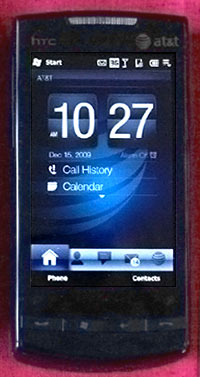Gifts of Christmas 2009: HTC Pure on AT&T
Windows Mobile in recent years has become the forgotten mobile OS. On AT&T’s network its phones inevitably sit behind the shadow cast by the iPhone. On other networks Windows Mobile faces a similar problem from phones like the Droid and Pre. Yet, HTC continues to quietly, but successfully create enticing phones based on the OS. The HTC Pure is one of those Windows Mobile devices.
The Pure is a compact, 3.2” touch screen phone. It is more rectangular than many current devices, yet it appears anything but boxy. The case is an interesting metallic plastic that appears mostly black but includes a hint of blue when in the light. A few brushed metal accents add to the phone’s pleasing appearance. As usual for HTC, this phone feels extremely solid; the form of this device also made it particularly comfortable to grip while talking.
Our only real gripe with the hardware design is that HTC has opted, as they do in some of their other phones, to omit a headphone jack, thus requiring one to connect the included “ExtUSB” adapter to the phone and then connect the headphones through the adapter.
As a comparison to its HTC siblings, it is smaller than HTC’s other WM6.5 handset we have looked at, the Imagio, but about the same size as the Android-powered HTC Hero (or Droid Eris). While we do like large screen sizes, the Pure never felt cramped and the compactness was certainly appreciated. (Because of the similarities of the Imagio and the Pure, much of what we said concerning the Imagio is also relevant to this device.)
 |
|
The HTC Pure has a clean, attractive design and very good quality screen . |
The Pure runs HTC’s proprietary TouchFLO 3D interface. HTC has really gotten the hang of customizing the platforms it produces phones for and TouchFLO is not only the best skin over Windows Mobile we have seen, it is simply one of the best smart phone interfaces available at the present time.
We like that virtually all of the core features of the phone can be accessed quickly using the tab bar located at the bottom of the home screen (and which remains visible throughout the various screens it provides access too). One can, for example, slide over to the stocks tab to check out a customized portfolio of stocks and funds before sliding again into the weather app to see what the forecast is.
The Pure also features a contacts tab that allows one to pull favorite contacts out of the phone’s address book (or a connected Exchange server). If the contacts are attached to a picture, the favorite contacts screen will allow one to flip through the contacts as though they were a stack of photos. This is a rather fun approach to contact management and also a practical one for rapidly locating someone without much concentration required. A similar stack-type approach is used for the media player and photo viewer tabs, allowing one to “swipe” through the contents of the phone easily.
HTC’s signature touches appear, including an amusing – but tasteful – windshield wiper that wipes away the “rain” when the forecast animation includes rain (the weather icon for rain has precipitation that collects on the screen). The interface, while sleek, is enhanced with these “soft” flourishes that make it feel lively and organic. HTC’s work is notable in this regard, because too many attempts to create such an experience with technology go overboard and create something “cutesy” rather than helpful. We find TouchFLO instead actually accomplishes its goal, creating something pleasant to use and pleasing to the eyes.
The phone’s voice functionality worked well. We found it to be natural and did not notice the slightly mechanical sound we had previously observed in the Imagio. The phone has an excellent speakerphone as well.
We found cellular reception seemed somewhat weaker on the Pure than the iPhone 3GS or Imagio. While it was not much of an issue in our testing area, we did notice that areas were the signal was somewhat weak for the iPhone 3GS, the Pure had a more difficult time pulling in a connection. On the other hand, when reception was fine, the Pure was extremely snappy, taking advantage of AT&T’s fast 3G network.
As with other TouchFLO-infused devices (or other, similarly “skinned” devices from other manufacturers), the biggest disadvantage for the Pure is that when one crosses from the parts of the phone featuring HTC’s proprietary interface and into the generic Windows Mobile look, the phone becomes significantly less touch friendly. We noted this same issue with the Imagio. It is hard to fault HTC for this: the company covered almost every commonly used part of the device with its own touches.
As with most current Windows Mobile devices we have seen, the Pure comes bundled with Opera as its default web browser. Opera does a capable job of rendering current web pages and its interface feels well suited to the TouchFLO UI it is surrounded by. We would love to see multi-touch gestures brought to Opera in the future to ease navigation.
 |
|
The HTC Pure (left) produced less properly exposed, blurrier shots than the iPhone 3GS (right) . |
The camera on the Pure was usable, but not as good as what we have seen from some other recent phones. Colors were often washed out and photos were typically either under or overexposed. We also found the camera was particularly prone to blurry shots. The iPhone 3GS, while lower in resolution, performed significantly better, creating crisper, brighter photos in the same locales.
Overall, Windows Mobile continues to feel like the weakest link for the devices it runs, despite Windows Mobile 6.5’s enhancements that have been aimed at modernizing it and do help to a certain extent. We continue to think that the strongest platforms going forward are iPhone OS and Android, which are touch friendly from the ground up, offer lively app stores and have rapidly growing user bases.
While Android is not yet available on AT&T (though reliable rumors suggest that will change soon), our favorite smartphone on any carrier, the Apple iPhone 3GS, graces the same network as the Pure for just $50 more, and its older sibling, the iPhone 3G, is actually $50 less than the Pure. Since its release two and a half years ago, the iPhone has continued to raise the bar for mobile interface design and it also offers access to the world’s largest mobile application store. We recommend a serious examination of the iPhone before jumping onto Windows Mobile.
Nevertheless, for those who depend on applications made specifically for Windows Mobile, especially enterprise-level software, or for those who simply want to blaze a trail with something different that is still extremely usable, the Pure covers as much of Windows Mobile as possible, allowing the user to retain access to Window Mobile’s features and large selection of applications while spending most of his or her time in the truly beautiful TouchFLO interface.
What the Pure offers is not so much a potential iPhone killer, but rather an interesting alternative that offers a pleasant, intuitive touch-driven interface on AT&T’s network. Those looking for such a phone certainly will find an excellent little device in the Pure, whether you are trying to do a little last minute Christmas shopping or are in the market for a phone for yourself (HTC/AT&T, $149, www.att.com).